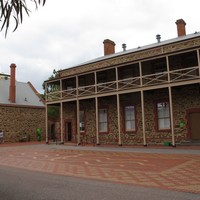Place
ContributeAlthough colonial planners envisaged that South Australia would be a utopia without unemployment and poverty, from the beginning many settlers appealed to the colony’s emigration agent for government assistance, and some vulnerable immigrants were housed in Emigration Square.
Despite an 1843 act providing that relatives were responsible for the support of family members, the South Australian government found itself reluctantly supporting destitute people who had no relatives in the colony. Private charities also came to their aid. By March 1856 a quadrangle of buildings in Kintore Avenue off North Terrace known as the Destitute Asylum, the first institution of its kind in the Australian colonies, was providing ‘indoor relief’ to 65 women, 30 men and 43 children. Fifteen of the women were either in the final stages of pregnancy or recovering from childbirth; ten had the added stigma of being unmarried. ‘Outdoor relief’ in the form of rations was provided to a further 693 South Australians throughout the colony.
Attempting to make the receipt of government welfare as unattractive as possible, legislation in 1863 and 1867 set down rules and regulations for the management of asylum inmates. They were required to wear a uniform, and to rise, eat and retire at set times. The able-bodied were obliged to work, men in the asylum gardens and women in the traditional pursuits of cooking and sewing. Inmates were only permitted to leave the premises one afternoon a week, and allowed to see visitors for three hours every Wednesday; parents were allowed to see their children for just two hours once a month. Despite these measures, in 1865 approximately 150 of the 1276 colonists dependent upon the government lived in the Destitute Asylum. In September 1872 the South Australian Register reported that 2085 South Australians were receiving outdoor relief from the Destitute Board, while 176 males, 56 females and 15 pregnant women resided at the asylum. The newspaper acknowledged the asylum’s unofficial role as a home for the terminally ill and old, commenting that of these 247 inmates ‘75 per cent will most likely never quit it except by death’.
Various state and Commonwealth welfare provisions introduced after the turn of the century reduced demand for Destitute Asylum accommodation. It closed in 1918 and some of its buildings now house the Migration Museum.
Media
Add mediaImages

Image courtesy of the State Library of South Australia, SLSA: B 56722, Public Domain
Buildings
Images

By Bahudhara (Own work) [CC-BY-SA-3.0 (http://creativecommons.org/licenses/by-sa/3.0)], via Wikimedia Commons


History SA. South Australian Government Photographic Collection, GN13060.

History SA. South Australian Government Photographic Collection, GN13066.

Image courtesy of the State Library of South Australia, SLSA: B 6449, Public Domain

Image courtesy of the State Library of South Australia, SLSA: B 796, Public Domain
People
Images

Image courtesy of the State Library of South Australia, SLSA: B 3575, Public Domain

Image courtesy of the State Library of South Australia, SLSA: B 34154, Public Domain



Comments
CommentAdd new comment
What a connection Georgina. Is this him? http://nla.gov.au/nla.news-article210564449
I think my great great uncle Thomas Job Spender - or his father Charles Spender, was the builder for this building - as well as the Toll House at base of freeway.
Hi Janine,
The Destitute Asylum archives are all held at State Records: http://www.archives.sa.gov.au/ They have a public access building in the State Library of South Australia on North Terrace. They also have a fact sheet available on accessing Destitute Asylum Records: http://www.archives.sa.gov.au/content/ras-fact-sheets
Best of luck with your research!
Hi,
My Grandfather was in born into (or bought into soon after) this destitute asylum and I wondered if you have any records of the occupants around 1896? His name was Henry George Haines and his mother was listed on his birth certificate as Augusta Haines.
I'd be grateful for any information as I can't find any records of her being born or anything else, and trying to find out fathers name???
kind regards,
Janine
**********